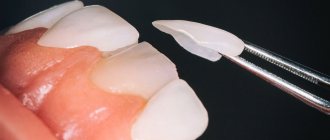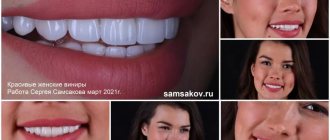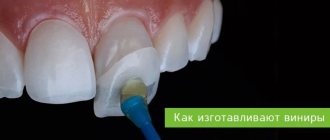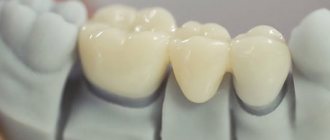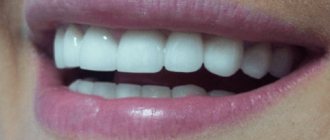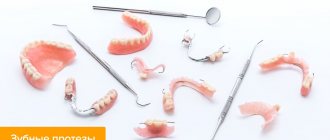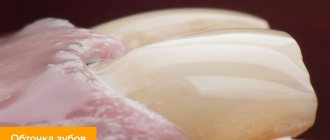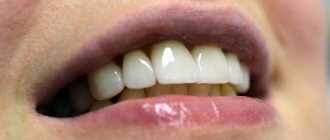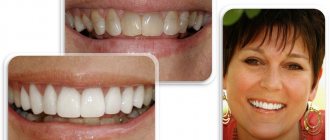A dental crown is a permanent prosthesis, which is a single element in the form of a “cap”, which is made from impressions in a dental laboratory, and then attached to the tooth.
Dental prosthetics with crowns help restore their shape and function, protect against caries and pulpitis. Modern dentistry offers reliable, durable and aesthetic orthopedic structures, which in appearance are practically no different from natural units.
Dental restoration with composite materials.
Dentistry is actively developing every year; people’s eternal desire for everything beautiful has motivated specialists to create new, more advanced technologies for dental treatment and restoration. Over time, a new direction called aesthetic dentistry has emerged, which deals with these issues. It provides the opportunity to correct various cosmetic defects, and composite materials allow you to recreate the structure of the tooth, its anatomical shape and color. If filling only restores the functionality of the unit, then during its restoration the appearance is corrected. Let's talk in more detail about this unique technique.
Metal-ceramic crown
In search of a compromise between the unaesthetic appearance of metal and the insufficient strength of ceramics, dentists developed metal-ceramic dental crowns. During their manufacture, a ceramic coating is applied to a metal base, masking the metal, while the metal base provides sufficient strength and rigidity. The advantages of such structures include:
- reasonable cost;
- natural appearance;
- strength comparable to conventional metal prostheses.
Disadvantage: when the gum recedes, the metal part of the crown appears from under it, which reduces its aesthetic value.
About the procedure.
The main objective of the cosmetic restoration procedure is to restore and adjust the size and shape of the tooth and also improve its appearance. With its help you can solve several problems:
- Easily eliminate the consequences of carious damage. During the treatment of caries, all infected tissues are drilled out, and in their place a cavity is formed, which must be filled with a filling. Thanks to composite materials, the defect can be corrected and the crown of the tooth can be successfully restored.
- Change the shade of enamel. Due to age-related changes, due to treatment and other things, the appearance of our smile noticeably deteriorates, and with the help of modern photopolymer materials you have the opportunity to return the natural shade of tooth enamel.
- Hide large interdental gaps. Composite restoration allows you to hide visible imperfections such as trema and diastema.
- Correct uneven units. During restoration, it is possible not only to eliminate cosmetic defects of the teeth, but also to correct some defects, for example, to give the desired shape to the front incisors. But before the procedure, you should definitely consult with an orthodontist, because... For serious pathologies, the only treatment option is braces.
- Fill in the missing part of the tooth. Due to injury or carelessness, a small piece of a person’s crown may break off. So that this deficiency does not cause inconvenience, it can be corrected by building up the missing part with a composite.
Cosmetic restoration is carried out using several methods, depending on what the patient wants and what problems he has, one of them is selected. To achieve an excellent effect, the A-medic clinic uses only high-quality composite materials, which allow you to achieve complete color similarity and look natural. This procedure is mainly used as the final stage of caries treatment; using a light-curing composite, the doctor restores the shape of the damaged tooth, recreating its crown part almost anew. This kind of work requires a professional who can take into account the anatomical features of the incisors, molars and canines and reproduce all the tubercles and irregularities on their chewing surface. If everything is done efficiently, the patient will not even be able to feel or touch the filling with his tongue.
Ceramic crown
Ceramics is the most suitable substance for making teeth, since in its composition and structure it is very close to tooth enamel. Ceramic crowns are an ideal option for prosthetic restoration of anterior teeth, as they provide the most effective aesthetic replacement.
So the advantages:
- excellent aesthetic effect;
- excellent prosthetics for both frontal and chewing teeth;
- resistant to dyes.
E-max glass-ceramic crown prostheses are becoming increasingly popular.
Contraindications.
Composite restoration, although it belongs to the section of aesthetic dentistry, is still a medical procedure and has a number of absolute contraindications. It cannot be performed if the patient is allergic to the materials used, has acute gum disease and has numerous caries. There are also several relative contraindications that should also be kept in mind:
- Destruction of tooth tissue by more than half.
- Absence of outer molars.
- Bruxism (teeth grinding).
- Abrasion of teeth.
- Malocclusion.
Metal composite crowns
Another attempt to combine metals and non-metals in dental crowns is metal composite crowns. Their peculiarity lies in the manufacturing method - a light-curing composite is applied to a metal base. A new tooth is formed, similar to a real one. Such dental crowns are very attractive from an aesthetic point of view; they look very good both in place of the front teeth and in the place of chewing teeth.
But there are more disadvantages than advantages.
Features of composite dental restoration.
Composite materials have been used in dentistry for over 50 years. And every year their quality improves, they become more reliable and durable. During the restoration process, the composite bonds to the surface of the tooth, strengthening and restoring its integrity. In some cases, when the crown is almost half destroyed, this restoration method is even preferable. It allows you to avoid depulpation (removal of the nerve) and the unit will not need to be ground down for an artificial insert.
Nowadays, almost all specialists have begun to use photo-curable materials in their work; with their help, you can achieve excellent aesthetic results. Of course, such structures as veneers, inlays and crowns greatly simplify the adjustment process; you just need to glue them on and your smile is already transformed. In the case of composite restoration, the dentist selects the appropriate shade of the material, carefully recreates parts of the damaged tooth, not forgetting about its features, tubercles and fissures. But even taking this fact into account, this aesthetic dentistry service has a number of advantages:
- The procedure is performed in one step.
- Reasonable price.
- Subject to the dentist's recommendations and proper care, the appearance of the restored teeth will remain for a long time.
- If the patient is not satisfied with the result, the restoration can be redone.
- Minimal grinding of healthy tooth tissue.
Prices
| Primary appointment (examination, consultation) with an orthopedic dentist | 1,150 rub. |
| Repeated appointment (examination, consultation) with an orthopedic dentist | 100 rub. |
| Tooth restoration with a temporary crown using the direct method | 2,500 rub. |
| Tooth restoration with a permanent crown (CEREC method) | 32,000 rub. |
| Tooth restoration with a permanent metal-free crown “Imax” with individual aesthetics (application method) | 35,000 rub. |
| Tooth restoration with a permanent metal-free ceramic milled crown | 28,000 rub. |
| Tooth restoration with a permanent metal-ceramic crown | 15,000 rub. |
| Tooth restoration with a permanent all-metal crown | 6,000 rub. |
| Restoring a tooth with a crown using a solid core inlay | 7,000 rub. |
| Restoring a tooth with a crown using a solid core inlay. Stump inlay made of zirconium dioxide | 15,000 rub. |
| Tooth restoration with a crown. Combined tooth. Metal-ceramic crown on an implant | 20,000 rub. |
| Trephination of tooth, artificial crown | 500 rub. |
Methods of dental restoration.
In dentistry, there are two options for aesthetic restoration. The indirect method is used in more complex cases where it is necessary to restore severely damaged units and correct serious cosmetic defects. In this case, the whole process is extended over several appointments: first, the doctor conducts an examination and takes impressions, and then sends them to the laboratory where the restoration elements will be made. Another technique is direct restoration, which involves the use of composite materials. All manipulations are carried out directly in the patient’s mouth, in the dentist’s office. Sometimes the procedure can last several hours, which causes discomfort for the patient. In case of more significant chips and destruction of the unit, to strengthen it and to secure the filling well, a pin is installed in the root canal.
Stages of composite restoration.
Let's take a closer look at the stages of direct dental restoration.
- Preparatory.
To begin with, the dentist will conduct an examination, assess the condition of the teeth and gums, and, if necessary, prescribe oral sanitation. In order for the color of the restored area to be identical to the natural one, it is necessary to clean the teeth of plaque and stone. Only after this can a specialist correctly determine the appropriate shade of the composite.
- Cleansing.
For a painless procedure, the patient is given an injection with anesthetic drugs. After the anesthesia begins to take effect, carious tissue, remnants of old fillings and other contaminants that may cause poor contact between the photopolymer and the crown are removed from the surface of the tooth.
- Tooth shape modeling.
The filling material is applied in layers, the dentist combines different shades of the composite, creating a natural shade. At the same time, he tries to recreate the appearance of a natural tooth, taking into account its anatomical features. At the end of the procedure, the chewing surface of the unit is polished and ground so that nothing disturbs the patient.
Installation
The process of dental prosthetics with crowns is implemented in practice by two main methods:
- pin installation. A pin is screwed into the pre-filled root canal, and the coronal part is restored using it. After the filling is made, it is ground down for installation of a crown;
- use of a stump tab. This element is made in a laboratory. During installation, the inlay is fixed simultaneously in two areas - in the area of the natural crown and in the dental canal.
Recommendations for care.
As soon as the specialist completes his work, you will be able to admire your irresistible smile, without any cosmetic defects. To maintain the results obtained for many years, you must follow a few simple rules. Their implementation will not be difficult for you at all, but at the same time your teeth will remain intact.
- Eliminate food and drinks containing dyes from your diet for a day after the procedure. In the future, also try to avoid consuming highly colored foods, carbonated water, red wine, coffee, etc.
- Don't forget about regular dental checkups and professional oral hygiene.
- On the first day after restoration, women should not wear bright red lipstick.
- The restored areas of the teeth may not withstand heavy loads, so you should not bite seeds, nuts, or chew sticky food.
- Use a toothbrush with soft bristles; it will avoid rapid abrasion of the filling material.
Metal crown
Dentures began to be made from metal almost 100 years ago. Initially, preference was given to gold - crowns were made from it quite simply, but were too soft. Gradually, a special gold-based alloy began to be used for crowns - the addition of other metals makes it possible to achieve high strength of the product.
Nowadays, dentists use not only precious metals (gold and silver) to make crowns, but also “base” metals: titanium and steel. All metal crowns have a rather low aesthetic quality - the presence of gold teeth in the mouth currently does not make a person beautiful. In addition, the cost of such products is actually not considered one of the lowest.
How and why dental crowns are removed
A well-made dental crown can be worn for decades, of course, if the material from which it is made is designed for this. However, standard recommendations are to replace it every 10 years or more frequently as required.
Premature removal is carried out when certain unpleasant symptoms appear, most often indicating incorrect installation. So, crown removal is carried out when the following symptoms appear:
Crown pain
Although modern techniques for working with materials make it possible to ensure a filigree match of the crown to the prepared tooth, sometimes situations arise that the patient complains of pain in the crown. Of course, it is not the tooth that hurts, but the tooth on which it is installed. Among the causes of pain, caries is the leading cause; less often, pain occurs with untreated roots.
Unpleasant smell
The appearance of a putrid odor may be due to the fact that food particles are packed under the crown. Due to the inability to remove them even with the help of high-quality teeth cleaning, they become contaminated with bacteria and decompose, which is accompanied by a putrid odor.
Plastic dental crowns
Dental crowns made from plastic are the cheapest option of all types of dental crowns. They are made the fastest and easiest, the cost of material for them is the lowest. Most often, temporary crowns are made from plastic and placed on patients while permanent crowns are made from a different material.
Pros:
- fast production;
- ease of installation;
- cheapness.
Flaws:
- wear out quickly - service life does not exceed 2 years;
- low strength - it is not recommended to install them on chewing teeth;
- low aesthetic value.
What determines the cost of a dental crown?
The final cost of prosthetics is influenced by several important factors:
Pricing policy for a specific dentistry: All private clinics target a specific cohort of consumers with approximately the same level of income. Therefore, the cost of the same prosthesis can vary dramatically. DENT Academy does not offer the lowest prices - we offer very high-quality work at an adequate cost.
Cost of materials: It is logical that plastic dentures are much cheaper than zirconium dioxide, so when choosing a specific type of dental crown, you should focus on your financial capabilities. Our clinic specialists will help you choose the best option that combines high quality with an affordable price.
The clinic has its own dental laboratory: The technological process of making dentures is financially very expensive. If there is no laboratory, the clinic is forced to enter into an agreement with an independent laboratory. Naturally, the cost of such prostheses will increase, if only because of logistics costs.
Qualification of personnel: it is natural that when a doctor with extensive experience and work experience receives more money for it, accordingly, the cost of his work will be higher than that of a young specialist who has no experience and whose quality of work is unknown. The price of dentures also includes the cost of paying for the work of a dental technician, whose qualifications largely determine the quality of the manufactured crown, especially when it comes to high-tech structures.
Types of removable dentures
This category includes designs that can be removed, cleaned, and put on independently, without the help of a specialist. They are indicated for complete or partial absence of teeth; they can be permanent or temporary. The following types of removable dentures are distinguished:
- lamellar;
- clasp;
- immediate dentures;
- quadrotti;
- sandwich dentures.
Removable prosthetic structures perform an aesthetic function and promote better chewing of food. The advantages of this method of prosthetics include speed of installation and relatively low cost. Permanent structures have significantly more disadvantages.
First, the gum tissue atrophies, making it necessary to replace the artificial jaw every 2 or 3 years. Secondly, plate dentures are not securely fixed in the oral cavity and can distort diction. Thirdly, the materials used wear out quickly and are not very durable. Below are detailed characteristics of each type of removable dentures.
Suction cup or plate prosthesis
An inexpensive and simplest method of prosthetics for complete or significant absence of teeth. The prosthesis consists of a base made from an individual impression and crowns. To make the base, hard hypoallergenic materials (acrylic, plastic) or soft nylon are used.
If several dental units have been preserved, the artificial jaw is attached to them using clasp hooks. In the case of complete edentia, fixation is carried out by suction of the base bed to the gum tissue. For more reliable fastening, dentists recommend using special adhesive compounds (creams, glues).
Complete removable dentures for the upper jaw have a design feature. They completely cover the palate, which increases their surface area and, accordingly, the reliability of fixation in the oral cavity. Prosthetics of the lower jaw in a similar way is undesirable, because the product, without a palatal part, is less well retained in the mouth.
Dentists do not recommend this type of prosthetics for several reasons:
- due to the high load on the gums, hard and soft tissues quickly atrophy, which leads to the need for frequent replacement of dentures;
- design features often contribute to impaired diction and can provoke an inflammatory process;
- patients complain of a long process of getting used to it, discomfort while wearing it, and gagging;
- the prosthesis is not sufficiently securely fixed in the oral cavity, restoring chewing function by no more than 65%;
- the materials used in manufacturing are not very durable; plastic can cause an allergic reaction.
Removable prosthetic structures are still in high demand because they are inexpensive, quickly manufactured, and easy to maintain.
Immediate prosthesis
Also known as a “butterfly” or “bug”, it is a temporary type of prosthetics for 1-3 dental units. It is usually installed before implantation for the period necessary for the engraftment of titanium pins. At this time, a removable denture is necessary to maintain chewing function, maintain aesthetics, and also to prevent tooth discrepancy.
The design received its name due to the similarity of its supporting part to the open wings of an insect. The base is usually made of soft materials, colored to match the gum, and the crowns are made of white acrylic plastic. The denture is attached to healthy teeth using clasps, which are almost invisible when smiling or talking. Immediate dentures are inexpensive, are manufactured in 2-3 days, and look aesthetically pleasing.
Immediate prosthesis
Clasp prosthesis
One of the highest quality modern types of prosthetics for partially edentulous patients. The design is comfortable to wear, aesthetically pleasing, and durable. In addition, the chewing load is evenly distributed between the supporting dental units, which significantly slows down bone tissue atrophy. To install this type of structure, you must have your own healthy teeth on both sides of the jaw.
The clasp prosthesis consists of three main parts:
- metal frame made of titanium, precious metals or cobalt-chromium alloy (CHC);
- a base made of nylon or acrylic, with plastic teeth;
- fixation systems (locks, clasps, telescopic crowns).
The basis of the metal frame is an arc, which serves as a load distribution and ensures the strength of the entire structure. On the upper jaw, it can be in three positions - in front, in the middle or behind - or have a closed ring-shaped shape. when replacing the lower jaw, this element has an exclusively anterior position.
The arc does not come into contact with the mucous membrane and has a small thickness. A nylon or acrylic base with crowns is welded onto it. The thickness and volume of the base are reduced due to the presence of a durable metal frame. This increases the comfort of wearing clasp structures and makes them one of the best dentures for teeth. The reliability of fixation in the oral cavity depends on the type of attachment to the supporting dental units.
On clasps
This is the name for hooks that are placed on healthy crowns, transferring pressure to them and keeping the prosthesis from moving. They are usually made of metal, but if they fall into the smile zone, they can be made of nylon (it is almost invisible). Clamp fastening has the following advantages:
- reliable fixation;
- comfort, quick adaptation;
- no need to grind your own crowns;
- affordable price (compared to other options).
The disadvantages include low aesthetic characteristics, but this only applies to metal clasps. In addition, such fastenings negatively affect the condition of supporting teeth, accelerating their destruction. The reason is the slight elasticity of the hook required to remove or put it on. As a result, it becomes mobile, gradually wearing away the enamel. But this problem can be solved by installing metal-ceramic crowns.
On locks
Fixation of the prosthesis is ensured by metal micro-locks or attachments consisting of two parts. One of them is located on the prosthesis itself, and the second is on the metal-ceramic crown of the abutment tooth. The design of this fastening is reliable and also redistributes about half of the chewing load onto healthy teeth.
The advantages of clasp dentures with attachments include:
- high aesthetics - the locks are located on the inner surface of the teeth, therefore they are completely invisible;
- reliable fixation;
- long service life - about 7 years;
- high rates of restoration of chewing function;
- no pain, discomfort, quick adaptation.
Among the disadvantages, one can highlight the rather high cost of production, which is due to its complexity. In addition, for prosthetics, it is necessary to grind down your own teeth in order to install metal-ceramics.
On telescopic crowns
The most technically complex, but the most effective way to fix the prosthesis in the mouth. The fastening element consists of two parts - a metal cap and a metal-ceramic crown. The first of them is placed on a ground healthy tooth, and the second is attached to the frame of the prosthesis. During installation, the crown is placed on the cap, ensuring the most reliable fixation. Therefore, to the question of which clasp dentures are the best, we can confidently answer that these are the ones.
The advantages of products with telescopic crowns include:
- reliability;
- durability;
- aesthetics.
The main disadvantage of this type of construction is its high cost, since it is necessary to install crowns on at least 4 abutment teeth.
Quadrotti
The name of the design comes from the Italian QuattroTi - the latest development by European scientists in the field of prosthetics. The principle of manufacturing and fixation of the prosthesis is similar to the clasp one, but differs in the material of manufacture. Instead of metal, it uses acetal - a monomer-free plastic, which is characterized by increased strength, 100% hypoallergenicity, and lightness.
Quadrotti prosthesis
This material made it possible to improve the performance qualities of the artificial jaw without compromising other significant properties. The weight of the structure has decreased, the strength is not inferior to its metal counterpart, and there is no risk of allergic reactions. In addition, Quadrotti clasps, made of acetal, are completely invisible on the teeth.
QuattroTi clasp dentures are superior to their clasp-based counterparts in the following indicators:
- aesthetics – the material for making fasteners is available in ten shades of white;
- comfort – the design is light and non-bulky, so adaptation occurs quickly and diction is not impaired;
- long service life - at least 7 years;
- hypoallergenic - unlike metal, acrylic or plastic, it is not able to provoke an allergic reaction.
Quadrotti prostheses are not inferior to their metal counterparts in strength, but have one significant drawback. Their clasps do not perform a supporting function, but only hold them, so there is no redistribution of the chewing load on the supporting teeth. All the pressure is placed on the gum tissue, which can cause pain when chewing. In addition, the price of QuattroTi is higher.
Sandwich
This is the name of a new generation of removable prosthetic structures for the upper jaw without a palate. It is a domestically developed product, made from acrylic plastics. It is recommended for patients who have retained at least two of their own teeth that will serve as supporting teeth. This type of dentures is also suitable if there are no teeth, but 2 implants are installed.
The base is fixed on the gum due to two fasteners that repeat the anatomical shape of the existing dental units. Due to the absence of the palatal part, the product is superior to the standard removable analogue in the following respects:
- does not cause a gag reflex;
- does not provoke inflammation;
- does not impede diction;
- no need to remove at night;
- no need to use adhesives;
- more durable and lighter.
The only disadvantages of the sandwich can be considered a higher cost or the need to install two implants if your own teeth are completely missing.

